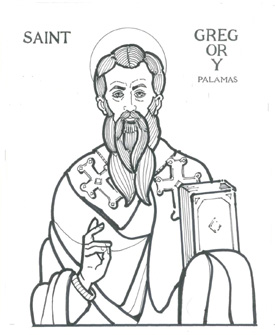
Saint Gregory Palamas
Gregory Palamas was born in 1246 after his parents were driven by the Turkish invasion of Asia Minor to Constantinople. Until 1316, Gregory was engaged in secular studies, the basic classics that gave him a considerable amount of Aristotle’s ideas. Palamas speaks Aristotelian logic as pure exercise; a technique of reasoning that is useful and legitimate for a Christian. About 1316, Gregory suddenly decided to follow the monastic vocation inspired by contact with eminent monks in Constantinople and then Mount Athos in Greece.
He was a practitioner of a method of prayer called Hesychasm, which we now call deep meditation (hesychia means silence). By this method utilizing a bodily discipline in order to unite his mind in God through continuous repetition of the name Jesus, the Christ, usually in the form of the Jesus Prayer: “Lord Jesus Christ, Son of God, have mercy on me a sinner.” Through the use of this method of prayer, the Hesychast monks claimed to gain genuine communion with God, including the spiritual of the Uncreated Light of Divinity such as that seen by Moses on Mount Sinai, and the apostles of Christ at the transfiguration of the Lord on Mount Tabor.
In 1326 the Calabrian Barlaam, a Greek former Uniate and a representative of the merging humanist tradition of the Western renaissance, came to Constantinople. Barlaam and some Byzantine humanists who were highly influenced by Western philosophical and theological ideas, ridiculed the practice of Hesychast prayer. They generally denied the possibility for men to be in genuine union with God. In 1333,Gregory Palamas confronted Barlaam’s position and defended Hesychasm. He established the Orthodox doctrine that man can truly know God and can enter into oneness with Him through Christ the Word and the Uncreated Energy, the Holy Spirit of the Trinity.
Essence and Energy
A council in 1346 upheld Gregory’s teaching. The holy monk made the famous distinction between the unknowable and the incomprehensible Essence or Superessence of God, and the actions, operations, or energies of God which are truly uncreated and divine (such as the divine light). These energies are communicated to men and are open to human participation, knowledge, and experience as the Holy Spirit.
After some years of political turmoil and theological controversy, councils held in 1347 and in 1351 (the year that Gregory became archbishop of Thessalonika) again upheld Gregory’s position as exactly that of the bible and the tradition of the Orthodox Church. Since that time the theological distinction between the divine Superessence and the divine energies has become an official part of the doctrine of the Orthodox Church. Gregory Palamas was canonized a saint by the Orthodox Church in 1368–just nine years after his death in 1359.
Gregory Palamas establishes my theological position that the Creative Energy and the Spirit of the Trinity is the same. He also confirms for me the value of an intimate relationship with God, by validating the oneness with God through silence.
Copyright © 2003-2009 Father Maximus Gregorios
All Rights Reserved